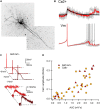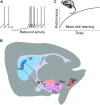Function and Regulation of ALDH1A1-Positive Nigrostriatal Dopaminergic Neurons in Motor Control and Parkinson's Disease
- PMID: 34079441
- PMCID: PMC8165242
- DOI: 10.3389/fncir.2021.644776
Function and Regulation of ALDH1A1-Positive Nigrostriatal Dopaminergic Neurons in Motor Control and Parkinson's Disease
Abstract
Dopamine is an important chemical messenger in the brain, which modulates movement, reward, motivation, and memory. Different populations of neurons can produce and release dopamine in the brain and regulate different behaviors. Here we focus our discussion on a small but distinct group of dopamine-producing neurons, which display the most profound loss in the ventral substantia nigra pas compacta of patients with Parkinson's disease. This group of dopaminergic neurons can be readily identified by a selective expression of aldehyde dehydrogenase 1A1 (ALDH1A1) and accounts for 70% of total nigrostriatal dopaminergic neurons in both human and mouse brains. Recently, we presented the first whole-brain circuit map of these ALDH1A1-positive dopaminergic neurons and reveal an essential physiological function of these neurons in regulating the vigor of movement during the acquisition of motor skills. In this review, we first summarize previous findings of ALDH1A1-positive nigrostriatal dopaminergic neurons and their connectivity and functionality, and then provide perspectives on how the activity of ALDH1A1-positive nigrostriatal dopaminergic neurons is regulated through integrating diverse presynaptic inputs and its implications for potential Parkinson's disease treatment.
Keywords: ALDH1A1; Parkinson’s disease; connectivity; dopamine; motor learning; substantia nigra.
Copyright © 2021 Carmichael, Evans, Lopez, Sun, Kumar, Ding, Khaliq and Cai.
Conflict of interest statement
The authors declare that the research was conducted in the absence of any commercial or financial relationships that could be construed as a potential conflict of interest.
Figures



Similar articles
-
Distinct Connectivity and Functionality of Aldehyde Dehydrogenase 1a1-Positive Nigrostriatal Dopaminergic Neurons in Motor Learning.Cell Rep. 2019 Jul 30;28(5):1167-1181.e7. doi: 10.1016/j.celrep.2019.06.095. Cell Rep. 2019. PMID: 31365862 Free PMC article.
-
Aldehyde dehydrogenase 1 defines and protects a nigrostriatal dopaminergic neuron subpopulation.J Clin Invest. 2014 Jul;124(7):3032-46. doi: 10.1172/JCI72176. Epub 2014 May 27. J Clin Invest. 2014. PMID: 24865427 Free PMC article.
-
Functional significance of aldehyde dehydrogenase ALDH1A1 to the nigrostriatal dopamine system.Brain Res. 2011 Aug 23;1408:81-7. doi: 10.1016/j.brainres.2011.06.051. Epub 2011 Jun 26. Brain Res. 2011. PMID: 21784415 Free PMC article.
-
Aldehyde Dehydrogenase 1 making molecular inroads into the differential vulnerability of nigrostriatal dopaminergic neuron subtypes in Parkinson's disease.Transl Neurodegener. 2014 Dec 10;3:27. doi: 10.1186/2047-9158-3-27. eCollection 2014. Transl Neurodegener. 2014. PMID: 25705376 Free PMC article. Review.
-
Involvement of the Protein Ras Homolog Enriched in the Striatum, Rhes, in Dopaminergic Neurons' Degeneration: Link to Parkinson's Disease.Int J Mol Sci. 2021 May 18;22(10):5326. doi: 10.3390/ijms22105326. Int J Mol Sci. 2021. PMID: 34070217 Free PMC article. Review.
Cited by
-
Deciphering the distinct transcriptomic and gene regulatory map in adult macaque basal ganglia cells.Gigascience. 2022 Dec 28;12:giad095. doi: 10.1093/gigascience/giad095. Epub 2023 Dec 13. Gigascience. 2022. PMID: 38091510 Free PMC article.
-
Multiple roles of ALDH1 in health and disease.Front Physiol. 2025 Jul 10;16:1627164. doi: 10.3389/fphys.2025.1627164. eCollection 2025. Front Physiol. 2025. PMID: 40708788 Free PMC article. Review.
-
Muscarinic receptor activation preferentially inhibits rebound in vulnerable dopaminergic neurons.bioRxiv [Preprint]. 2024 Jul 31:2024.07.30.605819. doi: 10.1101/2024.07.30.605819. bioRxiv. 2024. Update in: J Neurosci. 2025 Apr 16;45(16):e1443242025. doi: 10.1523/JNEUROSCI.1443-24.2025. PMID: 39131326 Free PMC article. Updated. Preprint.
-
Calbindin and Girk2/Aldh1a1 define resilient vs vulnerable dopaminergic neurons in a primate Parkinson's disease model.NPJ Parkinsons Dis. 2024 Sep 2;10(1):165. doi: 10.1038/s41531-024-00777-0. NPJ Parkinsons Dis. 2024. PMID: 39223183 Free PMC article.
-
Dendritic involvement in inhibition and disinhibition of vulnerable dopaminergic neurons in healthy and pathological conditions.Neurobiol Dis. 2022 Oct 1;172:105815. doi: 10.1016/j.nbd.2022.105815. Epub 2022 Jul 9. Neurobiol Dis. 2022. PMID: 35820645 Free PMC article. Review.
References
-
- Bentivoglio M., Morelli M. (2005). The organization and circuits of mesencephalic dopaminergic neurons and the distribution of dopamine receptors in the brain. Dopamine 21 1–107. 10.1016/S0924-8196(05)80005-3 - DOI
Publication types
MeSH terms
Substances
Grants and funding
LinkOut - more resources
Full Text Sources
Medical
Miscellaneous

